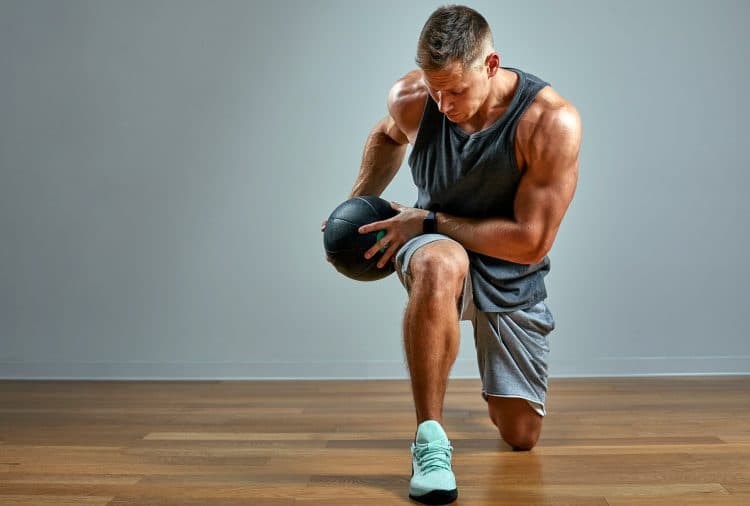Hypertrophy training programs are typically built around a range of variables. These include training frequency and split, exercise selection, rep range, number of sets per exercise and muscle group, and recovery time between sets.
In most cases, program writers put a lot of thought into things like the training split and exercise selection but very little into how much rest time you should take between sets. Some don’t even mention it, leaving you to fill in this missing piece of information yourself.
This is unfortunate because not only is the length of your interset rest a variable you can manipulate, but it may also have a direct impact on the effectiveness of your program.
In this article, we investigate how the rest time between sets can affect your progress and if there is an optimal rest time for building muscle.
Rest Time for Hypertrophy – The Standard Recommendation
While a lot of exercisers just rest as long as needed between sets, the standard recommendation interset rest period for hypertrophy training is 30-90 seconds. So, for example, if you do a set of bench presses, you would rest 30-90 seconds before beginning your next set.
Some lifters favor the short end of this scale (30-60 seconds), while others prefer slightly longer rests (60-90 seconds). Oftentimes, rest periods are modified depending on the exercise performed, e.g., less rest between sets of isolation exercises and longer rests for compound exercises.

Regardless of the exact duration, 30-90 seconds has worked for thousands of bodybuilders. It’s just long enough for levels of lactic acid to subside and to catch your breath. However, it’s not so long that your muscles recover fully, so each set will be more demanding than the one preceding it.
Resting from 30 to 90 seconds between sets will give you a good pump and burn, producing the mechanical and metabolic stress that is necessary for building muscle. However, while 30 to 90-second interset rests undoubtedly work, there are disadvantages too.
These include:
Accumulated fatigue
With incomplete rests between sets, your set-by-set rep count will probably decrease, reducing the quality and amount of work you can perform. This may have a negative effect on workout productivity.
For example:
- Set 1 – 12 reps
- Set 2 – 9 reps
- Set 3 – 7 reps
Alternatively, if you want your reps to remain more or less constant, you may have to reduce the weight as you get tired or hold back on your first few sets so you are less fatigued. Both of these strategies could make your workout less effective.
Cardiovascular overload
While hypertrophy training is generally anaerobic, a strenuous set of most compound exercises can leave you out of breath with your heart racing. Even if you are in good shape, you may find that when it’s time to do your next set, you are still out of breath, which limits how many reps you can do.
In short, your heart and lungs fatigue before your muscles. Doing fewer reps because you are out of breath will significantly undermine the effectiveness of your workout.
Needless to say, this effect is generally strongest with leg exercises as they demand the most oxygen and energy. This is one of the reasons that leg workouts are so hard (and daunting!).

The “rush factor”
Training with short interset rests means you have very little time between sets to gather your thoughts, get psyched up, change weights, grab a drink, update your workout diary, or do any of the other things that can help make your workout more productive. You may even start your next set before you feel ready and perform poorly as a result.
There is more to building muscle than just rushing through your workout. Successful hypertrophy training involves training smart, too. Short rests between sets definitely make for an intense workout. However, evidence suggests that longer rests may be more effective for building muscle.
Summary:
While 30-90 seconds is the traditional interset rest time for bodybuilding, it’s not without disadvantages, such as accumulating muscular and cardiovascular fatigue. However, given how many people have successfully used short rests to build muscle, it’s clear that it works.
In Support of Longer Rests for Hypertrophy
It’s generally accepted that longer rests (three minutes or more) are best for developing maximal strength. For example, maximum strength training typically involves lifting heavy weights (85%+ of your one-repetition maximum) for low reps (1-5 per set).
Low-rep, heavy-weight training creates less cardiovascular fatigue and minimal lactic acid compared to bodybuilding training. This suggests that shorter rests should work.
However, this type of training has a massive impact on the central nervous system, or CNS for short. The CNS controls how much force you can generate and needs to fully recover before you can lift the same load again.
This recovery takes time, and three minutes is considered the minimum rest period between sets of heavy lifts. Some exercisers rest five or more minutes between sets of very heavy strength training, even if their set only takes a few seconds to complete.

Longer rests for hypertrophy training
A growing number of studies and meta-analyses (a statistical analysis that combines the results of multiple scientific studies) suggest that more extended rest periods may result in more significant muscle growth and aren’t just for building strength (1).
Longer interset rests (3 to 5 minutes) allow you to lift heavier weights, creating more mechanical tension, and do more reps with that heavier weight, which is linked to greater hypertrophy.
This is expressed as your training volume, which is:
Reps x Weight x Sets
A higher overall training volume is usually associated with an increased adaptive response.
In addition, lifting big weights also builds more strength, making future workouts more productive, as you’ll be able to train even heavier.
Also, resting for three vs. one minute may lower the overall workout RPE or rating of perceived exertion, which is how hard you feel you are working (2). A high RPE is usually associated with feelings of fatigue and reduced motivation. In contrast, if your RPE is lower, you will be inclined to train harder and longer, leading to a more stimulating workout.
On the downside, resting more will make your workouts longer. This may be a problem if you are already pressed for time and struggle to fit training into an already-packed schedule.
Summary:
Longer rest periods allow you to do more reps with heavier loads, increasing training volume. Combined with a lower workout RPE, this should make your workouts more effective for hypertrophy, albeit only marginally. However, it’ll also make your workouts longer, which may be a drawback for some people.
How to Use This Information

While 30 to 90-second rests between sets undeniably work, there may be advantages to taking longer breaks. Resting for three vs. one minute could allow you to lift more weight or do more reps. It may also make your workout feel more manageable.
But how do you put this information into practice? And do you really need to overhaul your entire workout and double all your rest periods?
Probably not.
In fact, longer rest periods are probably best used with big, heavy, tiring compound exercises like squats, deadlifts, bench presses, overhead presses, and weighted pull-ups. After all, these are the most demanding and the most productive exercises.
For these exercises, longer rests are entirely appropriate and will ensure you reap all of the hypertrophic benefits they can deliver
In contrast, most isolation exercises are much less demanding and far easier to recover from, e.g., leg extensions, biceps curls, and lateral raises. As such, shorter rests are more applicable for these exercises.
So, using this information, a leg workout could end up looking something like this:
| # | Exercise | Sets | Reps | Recovery |
| 1 | Squats | 4 | 6-8 | 3 minutes |
| 2 | Romanian deadlift | 4 | 6-8 | 3 minutes |
| 3 | Leg press | 3 | 8-12 | 2 minutes |
| 4 | Leg extension | 3 | 12-15 | 90 seconds |
| 5 | Leg curl | 3 | 12-15 | 90 seconds |
| 6 | Calf raise | 3 | 15-20 | 60 seconds |
The rest periods get shorter as the exercises get easier, i.e., use fewer muscles or move from a high cardiovascular demand to a lower cardiovascular demand. You can apply this rationale to all body parts where you go from heavy compound to light isolation exercises.
Rest Time for Hypertrophy – FAQs
Do you have a question about how long to rest between sets for muscle growth? No problem, because we’ve got the answers!
1. So, how long should I rest between sets for hypertrophy?
Conceivably, you can rest anywhere from 30 seconds to 3-5 minutes between sets and build muscle. Shorter rests mean more metabolic stress, while longer rests allow you to lift heavier weights and do more reps.
According to science, longer rest periods are somewhat better for hypertrophy than short rests, but both can work.
So, try short (30-60 seconds), moderate (90 seconds to two minutes), and long (three minutes plus) rests and see which you prefer. Alternatively, adjust your rest period to the difficulty of the exercise you are performing and take advantage of the benefits of short and long rest periods.
2. Long rests between sets make my workout too long; got any solutions?
The biggest drawback to resting three minutes or more between sets is how much longer your workout will become. For example, it could add 30 minutes or more to your training session, which may be impractical.
One way around this is a method I call “lazy supersets.” Unlike regular supersets, where you move quickly from one exercise to the next, with lazy supersets, you transition more slowly, so one exercise will not affect your performance of the next but still makes good use of your recovery time.
For example, let’s say you’re training back and chest. For lazy supersets, do one set of bench presses, rest 60-90 seconds, and then do a set of pull-ups. Rest another 60-90 seconds and return to the bench press.
Using this method, you can rest for 3-4 minutes between sets without being completely idle and wasting so much time.
3. How much better are long rests than short rests for hypertrophy?
Studies suggest that the benefit of long vs. short rests is “statistically significant,” which means they can put a numerical value to it. However, in actuality, the benefits are pretty small, so it could be argued that there are more important things you should focus on, like exercise selection, training proximity to failure, eating right, and getting enough sleep.
So, if you like resting 30-90 seconds between sets and you’re happy with your progress, there is no need to change your approach. If you ARE missing out on any gains, it won’t be by much.
However, if you are training hard and consistently, eating right, and sleeping and recovering like a boss, longer interset rests may optimize your workouts, making each one as productive as possible (3).
Resting three instead of one minute means more downtime between sets. Here are a few things you can do during your longer rests:
- Stretching
- Pre-hab/rehab of other muscle groups
- Short bouts of cardio (e.g., 30 to 40 seconds of jump rope)
- Warming up for your next exercise
- A set of a non-competing exercise, e.g., calves or core
- Update your training diary
However, you should still keep track of your rest periods so you don’t get distracted. This is NOT the time to start updating your social media status or watching YouTube videos. Instead, stay focused on training. After all, that’s what you are there to do.
5. What is the best way to control my rest periods?
There are several methods you can use to control how long you rest between sets. Firstly, you could simply time yourself. Start your stopwatch (on your phone or wristwatch) as soon as you finish your last rep, and then start your next set three minutes later.
Or, if you only have access to a regular watch or clock, you can use the add-on method. Look at the time when you finish your set and add on however many minutes you need to rest. Do your next set at that time. For example, if your set ends at 17.00 and 45 seconds, and you want to rest for three minutes, start your next set at 17.03 and 45 seconds.
Finally, you can use a variation of EMOM, which stands for every minute on the minute. For example, let’s say your set takes an average of 40 seconds to complete, and you want to rest for three minutes between efforts.
Simply set a repeating alarm to sound every three minutes and 40 seconds. Start each set when you hear the beep; your rest periods should be roughly three minutes every time.
6. I like taking short rests between sets; do I really need to switch to longer interset breaks?
Most training methods have been studied scientifically. While some have been found to be better than others, the differences are often so small that it doesn’t really matter which one you do. The best one often comes down to personal preference.
For example, the benefits of doing three vs. one set, training to failure vs. close to failure, doing five vs. 15 reps per set, and full-body vs. split routines.
All of these methods produce similar results. Instead, what matters most is training consistency, and that usually hinges on enjoyment. Even the best program in the world won’t produce work if you don’t like it and, therefore, don’t do it.
So, while long rests may be slightly better for building muscle, if you prefer shorter rest periods between sets, then that’s the type of training you should stick to.
That said, don’t dismiss a type of training without trying it. Something that looks wrong on paper could be the missing training link you’ve been searching for.
So, give longer rests a try, but feel free to go back to shorter rests if that’s what you prefer. Be your own experiment, and build your workouts around what you enjoy and what works best for you.
Rest Time for Hypertrophy – Closing Thoughts
Many lifters feel guilty when they rest more than a minute or so between sets. They think they’re being lazy if they aren’t sweating, panting, and hustling from one set to the next.
However, research suggests that slowing down and taking more time between could allow you to train harder and heavier than shorter rests. This may help build muscle faster and will also enhance strength gains.
On the downside, longer rests invariably mean longer workouts, which may be problematic for busy lifters who already struggle to find the time to train.
So, don’t get too hung up on your rest periods. 30 to 90 seconds has been the go-to rest time for generations of bodybuilders. And if it worked for them, it’ll work for you too. But if you want to squeeze every last drop of productivity from your workouts, rests of three minutes or more could help.
References:
- Grgic J, Lazinica B, Mikulic P, Krieger JW, Schoenfeld BJ. The effects of short versus long inter-set rest intervals in resistance training on measures of muscle hypertrophy: A systematic review. Eur J Sport Sci. 2017 Sep;17(8):983-993. doi: 10.1080/17461391.2017.1340524. Epub 2017 Jun 22. PMID: 28641044. https://pubmed.ncbi.nlm.nih.gov/28641044/
- Senna, Gilmar W.; Willardson, Jeffrey M.; Scudese, Estevão; Simão, Roberto; Queiroz, Cristiano; Avelar, Raoni; Martin Dantas, Estélio H.. Effect of Different Interset Rest Intervals on Performance of Single and Multijoint Exercises With Near-Maximal Loads. Journal of Strength and Conditioning Research 30(3):p 710-716, March 2016. | DOI: 10.1519/JSC.0000000000001142 https://journals.lww.com
- Schoenfeld BJ, Pope ZK, Benik FM, Hester GM, Sellers J, Nooner JL, Schnaiter JA, Bond-Williams KE, Carter AS, Ross CL, Just BL, Henselmans M, Krieger JW. Longer Interset Rest Periods Enhance Muscle Strength and Hypertrophy in Resistance-Trained Men. J Strength Cond Res. 2016 Jul;30(7):1805-12. doi: 10.1519/JSC.0000000000001272. PMID: 26605807. https://pubmed.ncbi.nlm.nih.gov/26605807/
